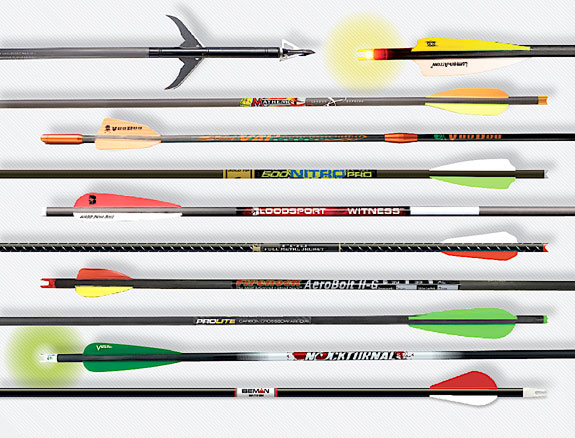It seems like in today’s adrenaline-hyped crossbow market, a great deal of emphasis is being placed on the speed of crossbows. Manufacturers are now using speed as the primary marketing tool to convince you to buy their crossbows because they shoot faster than others offered in the same price range. This need for speed does not necessarily guarantee that you are purchasing the best crossbow for hunting at a given price, and, if you are basing your decision solely on the advertised speed, you may be making a mistake.
TIPS FOR CHOOSING THE BEST CROSSBOW TARGET
Speed is the rate at which a projectile covers a given distance over a given period of time. Crossbow speeds are usually measured in feet-per-second (FPS). When a crossbow is said to shoot at 300 FPS, that means that when the arrow leaves the flight rail, it will travel 300 feet in the span of one second if it could maintain its momentum and trajectory. But it cannot. From the moment the arrow leaves the flight rail, drag forces begin to slow it down. Most advertised speeds for crossbows are measured at the muzzle, so the actual speed that the arrow moves downrange is going to be less than the advertised speed. This loss of speed is amplified the longer the distance you are shooting. Additionally, the lighter the arrow used is, the faster the arrow will slow at longer distances. Typically, advertised speeds use the lightest arrow recommended for use by the manufacturer to give you the absolute maximum speed that the crossbow will shoot. When comparing crossbow speeds, make sure that the speeds were determined using identical arrow weights.

CROSSBOW TIPS: WHAT TO DO WHEN IT DOESN’T SHOOT
Crossbow arrows come in many different weights, and these weights are measured in grains. This weight is the total finished arrow weight, which includes the insert, shaft, vanes and nock, and can range from lightweight (350 to 400 grains) to standard weight (400 to 445 grains) to heavyweight (445 to 750 grains). The muzzle speed of an arrow shot out of the same crossbow will change depending on the weight of the arrow that you shoot. If you shoot a lighter arrow, the speed will be faster than shooting a heavier one. Since most advertised bow speeds are determined by using the lightest arrow possible, unless you use this arrow, the speed at muzzle will be slower than advertised. For crossbow hunting purposes, you are better off to use a standard-weight arrow (400 to 445 grains). So, if you are planning to use the bow for hunting, you will likely not be shooting at the crossbow’s maximum speed. But, there are advantages to be gained by shooting a heavier, slower arrow.
Crossbows transfer the energy stored in the bow assembly to the arrow through the string, and accelerate the arrow down the flight rail. The crossbow delivers the same amount of force to the arrow when it launches it each time. A lighter arrow is easier to move from rest, so the crossbow will shoot a lighter arrow faster than it will shoot a heavier one. But for hunting purposes, you want to shoot an arrow that has the greatest amount of penetrating power, or kinetic energy, while still shooting as fast and as accurately as possible. Most hunters shoot an arrow in the standard weight range (400-445 grains) because they are willing to sacrifice a small amount of speed for a higher amount of kinetic energy. As compared to a lighter arrow, a heavier arrow will retain a greater amount of its energy at longer distances because of its greater tendency to want to stay in flight, and it will often shoot tighter groups. It also loses speed at a slower rate than a lighter arrow over a longer distance.
7 THINGS TO KNOW ABOUT DEER HUNTING WITH A CROSSBOW

Most modern crossbows launch arrows with far more kinetic energy than is needed to actually make a successful harvest shot on an animal, even when shooting a light arrow. Heavier arrows offer the ballistic benefits discussed above, but there is an additional benefit. After the crossbow shoots an arrow, energy is left in the bow assembly, which is absorbed and then dissipated out by the parts of the crossbow. The noise that you hear after the shot is directly related to the amount of energy that is remaining in the crossbow. The more energy that is left, the louder the noise will be. Remember that a heavier arrow requires more energy to be launched by the same crossbow than a lighter one does. When you shoot a heavier arrow, your crossbow will be quieter, since less energy remains to be absorbed and dissipated. Beware of crossbows that shoot at excessive speeds (such as greater than 400 FPS), as some will have more energy left in the bow assembly after the shot and will be much louder to shoot, with little practical gain from a hunting perspective. This additional energy also puts the parts of the bow assembly like limbs, cams, axles, string, cables and riser, through a greater amount of stress, which makes the failure of one of those components more likely to occur. Hence, the faster the crossbow shoots, the stronger the crossbow’s materials need to be to withstand the additional stress.
So, when buying a hunting crossbow, don’t get caught in the speed trap. Simply purchasing based on speed alone does not give you the highest-quality, longest-lasting or most consistently performing crossbow for the price.
— PAID PARTNER CONTENT. This content is brought to you by a D&DH advertising sponsor.



